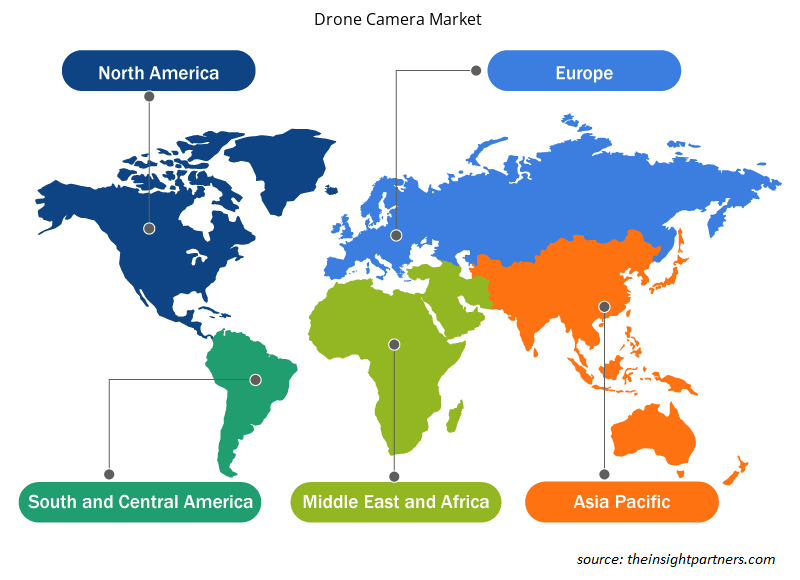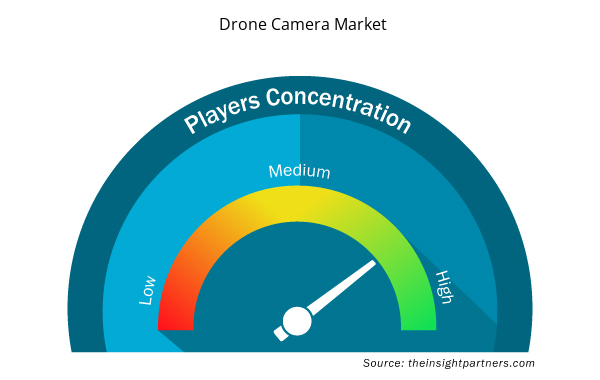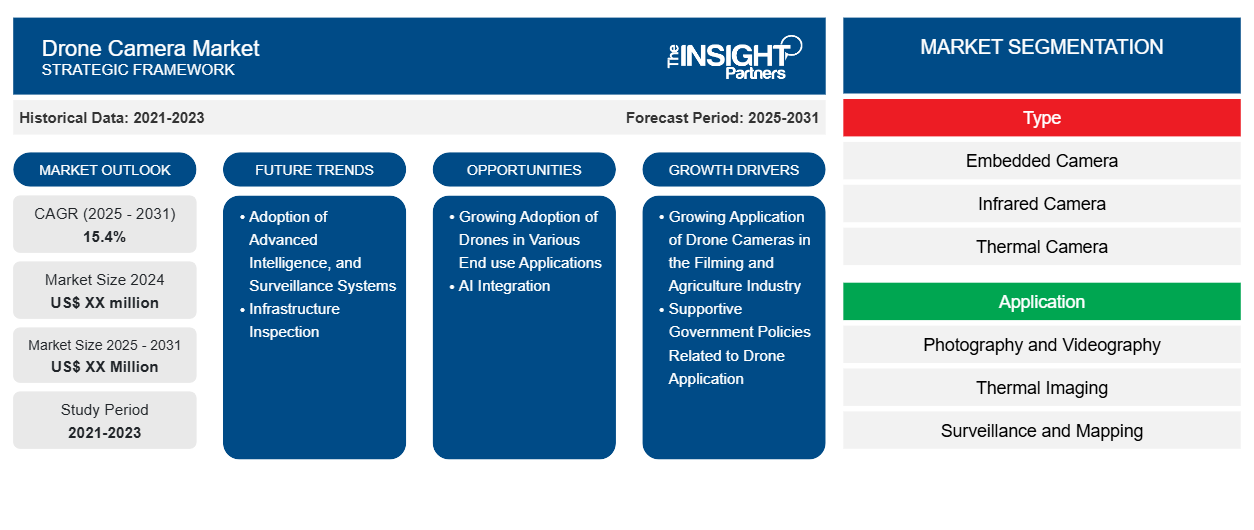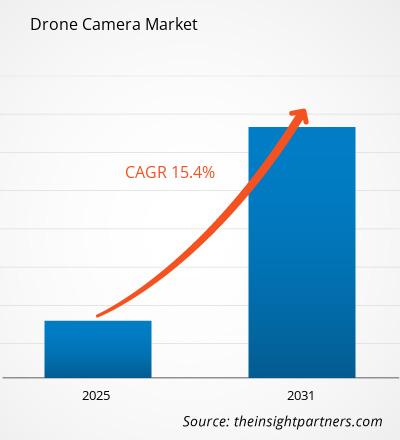Si prevede che il mercato delle telecamere per droni registrerà un CAGR del 15,4% dal 2023 al 2031, con una dimensione di mercato in espansione da XX milioni di dollari nel 2023 a XX milioni di dollari entro il 2031.
Il report è suddiviso in base a Tipo (Telecamera incorporata, Telecamera a infrarossi e Telecamera termica), Applicazione (Fotografia e videografia, Immagini termiche e Sorveglianza e mappatura), Risoluzione (Inferiore a 12 MP, 12-20 MP, 20-32 MP e Superiore a 32 MP), Utente finale (Intrattenimento e media, Difesa e forze dell'ordine, Trasporti e logistica, Edilizia e altri). L'analisi globale è ulteriormente suddivisa a livello regionale e nei principali paesi. Il report offre il valore in USD per l'analisi e i segmenti di cui sopra.
Scopo del rapporto
Il report Drone Camera Market di The Insight Partners mira a descrivere il panorama attuale e la crescita futura, i principali fattori trainanti, le sfide e le opportunità. Ciò fornirà spunti a vari stakeholder aziendali, come:
- Fornitori/produttori di tecnologia: per comprendere le dinamiche di mercato in evoluzione e conoscere le potenziali opportunità di crescita, consentendo loro di prendere decisioni strategiche informate.
- Investitori: condurre un'analisi completa delle tendenze relative al tasso di crescita del mercato, alle proiezioni finanziarie del mercato e alle opportunità esistenti lungo la catena del valore.
- Enti di regolamentazione: regolamentano le politiche e le attività di controllo sul mercato allo scopo di ridurre al minimo gli abusi, preservare la fiducia degli investitori e sostenere l'integrità e la stabilità del mercato.
Segmentazione del mercato delle telecamere per droni
Tipo
- Telecamera incorporata
- Telecamera a infrarossi
- Telecamera termica
Applicazione
- Fotografia e videografia
- Immagini termiche
- Sorveglianza e mappatura
Risoluzione
- Sotto i 12 MP
- 12-20 MP
- 20-32 MP
- Oltre 32 MP
Utente finale
- Intrattenimento e media
- Difesa e applicazione della legge
- Trasporti e Logistica
- Costruzione
- Altri
Utente finale
- Intrattenimento e media
- Difesa e applicazione della legge
- Trasporti e Logistica
- Costruzione
- Altri
Personalizza questo report in base alle tue esigenze
Riceverai la personalizzazione gratuita di qualsiasi report, comprese parti di questo report, o analisi a livello nazionale, pacchetto dati Excel, oltre a usufruire di grandi offerte e sconti per start-up e università
- Scopri le principali tendenze di mercato in questo rapporto.Questo campione GRATUITO includerà analisi di dati che spaziano dalle tendenze di mercato alle stime e alle previsioni.
Driver di crescita del mercato delle telecamere per droni
- Crescente applicazione di telecamere per droni nel settore delle riprese e dell'agricoltura: la crescente domanda di droni per riprese aeree e videografia nel settore dei media e dell'intrattenimento è uno dei principali motori del mercato delle telecamere per droni. La crescente applicazione di telecamere per droni di fascia alta per la cattura di video e immagini aeree grandangolari sta anche stimolando la crescita del mercato delle telecamere per droni a livello globale. Si prevede che la crescente proliferazione della digitalizzazione e dell'integrazione di applicazioni software per monitorare l'efficienza operativa complessiva dei terreni agricoli guiderà la crescita del mercato delle telecamere per droni a livello globale.
- Politiche governative di supporto relative all'applicazione dei droni: le politiche governative di supporto per i droni volanti aiutano nella gestione dei terreni agricoli, nella consegna dei pacchi in giornata, nelle riprese e nella fotografia e nel monitoraggio e nella cattura di immagini di siti di petrolio e gas e minerari. Pertanto, si prevede che il crescente supporto e assistenza governativi per l'utilizzo di droni avanzati per la sorveglianza, il monitoraggio e la sicurezza aumenteranno la crescita del mercato delle telecamere per droni nel periodo di previsione. I crescenti disordini geopolitici e le crescenti situazioni di guerra stanno spingendo l'applicazione delle telecamere per droni per scopi di sorveglianza, che si prevede guideranno la crescita del mercato delle telecamere per droni nel periodo di previsione.
Tendenze future del mercato delle telecamere dei droni
- Adozione di sistemi avanzati di intelligence e sorveglianza: i sistemi avanzati di intelligence e sorveglianza facilitano lo sviluppo di un'analisi completa e accurata, aiutando valutazioni delle minacce e incontri con gli obiettivi più dettagliati. Pertanto, le circostanze di guerra avanzata accentuano una maggiore consapevolezza della situazione, un migliore coinvolgimento degli obiettivi, sistemi di difesa integrati, capacità di guerra elettronica e conformità con minacce in evoluzione. Pertanto, l'adozione stimolante di dispositivi di guerra avanzati e veicoli di superficie spinge ulteriormente lo sviluppo di telecamere per droni per soddisfare le condizioni avanzate del campo di battaglia.
- Ispezione delle infrastrutture: i droni presentano un potenziale significativo nell'ispezione di infrastrutture critiche come ponti, linee elettriche e turbine eoliche, riducendo i costi e aumentando la sicurezza sostituendo le tradizionali ispezioni manuali.
Opportunità di mercato per le telecamere dei droni
- Crescente adozione di droni in varie applicazioni finali: la crescente proliferazione di telecamere per droni per il monitoraggio di qualsiasi situazione di emergenza come inondazioni, terremoti o incendi sta anche agendo come un importante motore per il mercato. Gli operatori di soccorso sfruttano principalmente i droni per scopi di sorveglianza e monitoraggio e per ottenere una visione aerea della situazione generale, il che aiuta a prendere decisioni importanti in merito alle modalità di avvio delle operazioni di soccorso. Inoltre, la crescente applicazione di droni nel settore dell'esplorazione petrolifera, del gas e mineraria sta anche avendo un impatto positivo sul mercato delle telecamere per droni a livello globale.
- Integrazione dell'intelligenza artificiale: i droni utilizzano sempre più l'intelligenza artificiale per migliorare il riconoscimento delle immagini e il volo autonomo, consentendo processi decisionali più intelligenti e una raccolta dati più efficiente, in particolare nei settori dell'agricoltura e della sorveglianza.
Approfondimenti regionali sul mercato delle telecamere per droni
Le tendenze regionali e i fattori che influenzano il mercato delle telecamere per droni durante il periodo di previsione sono stati ampiamente spiegati dagli analisti di Insight Partners. Questa sezione discute anche i segmenti e la geografia del mercato delle telecamere per droni in Nord America, Europa, Asia Pacifico, Medio Oriente e Africa e America meridionale e centrale.

- Ottieni i dati specifici regionali per il mercato delle telecamere per droni
Ambito del rapporto sul mercato delle telecamere dei droni
| Attributo del report | Dettagli |
|---|---|
| Dimensioni del mercato nel 2023 | XX milioni di dollari USA |
| Dimensioni del mercato entro il 2031 | XX milioni di dollari USA |
| CAGR globale (2023-2031) | 15,4% |
| Dati storici | 2021-2022 |
| Periodo di previsione | 2024-2031 |
| Segmenti coperti | Per tipo
|
| Regioni e Paesi coperti | America del Nord
|
| Leader di mercato e profili aziendali chiave |
|
Densità dei player del mercato delle telecamere per droni: comprendere il suo impatto sulle dinamiche aziendali
Il mercato del mercato delle telecamere per droni sta crescendo rapidamente, spinto dalla crescente domanda degli utenti finali dovuta a fattori quali l'evoluzione delle preferenze dei consumatori, i progressi tecnologici e una maggiore consapevolezza dei vantaggi del prodotto. Con l'aumento della domanda, le aziende stanno ampliando le loro offerte, innovando per soddisfare le esigenze dei consumatori e capitalizzando sulle tendenze emergenti, il che alimenta ulteriormente la crescita del mercato.
La densità degli operatori di mercato si riferisce alla distribuzione di aziende o società che operano in un particolare mercato o settore. Indica quanti concorrenti (operatori di mercato) sono presenti in un dato spazio di mercato in relazione alle sue dimensioni o al valore di mercato totale.
Le principali aziende che operano nel mercato delle telecamere per droni sono:
- Funziona bene
- Canone Inc.
- Controp Precision Technologies Ltd.
- Kappa optronics GmbH
- Società controllata da BaySpec, Inc.
- Teledyne FLIR LLC
Disclaimer : le aziende elencate sopra non sono classificate secondo un ordine particolare.

- Ottieni una panoramica dei principali attori del mercato delle telecamere per droni
Punti di forza chiave
- Copertura completa: il rapporto copre in modo completo l'analisi di prodotti, servizi, tipologie e utenti finali del mercato delle telecamere per droni, fornendo una panoramica olistica.
- Analisi degli esperti: il rapporto è compilato sulla base della conoscenza approfondita di esperti e analisti del settore.
- Informazioni aggiornate: il rapporto garantisce la pertinenza aziendale grazie alla copertura di informazioni recenti e tendenze nei dati.
- Opzioni di personalizzazione: questo report può essere personalizzato per soddisfare le esigenze specifiche del cliente e adattarsi in modo appropriato alle strategie aziendali.
Il rapporto di ricerca sul mercato delle telecamere per droni può quindi aiutare a guidare il percorso di decodifica e comprensione dello scenario del settore e delle prospettive di crescita. Sebbene possano esserci alcune preoccupazioni valide, i vantaggi complessivi di questo rapporto tendono a superare gli svantaggi.
- Analisi storica (2 anni), anno base, previsione (7 anni) con CAGR
- Analisi PEST e SWOT
- Valore/volume delle dimensioni del mercato - Globale, regionale, nazionale
- Industria e panorama competitivo
- Set di dati Excel



Report Coverage
Revenue forecast, Company Analysis, Industry landscape, Growth factors, and Trends

Segment Covered
This text is related
to segments covered.

Regional Scope
North America, Europe, Asia Pacific, Middle East & Africa, South & Central America

Country Scope
This text is related
to country scope.
Domande frequenti
Some of the customization options available based on the request are an additional 3-5 company profiles and country-specific analysis of 3-5 countries of your choice. Customizations are to be requested/discussed before making final order confirmation, as our team would review the same and check the feasibility.
The report can be delivered in PDF/PPT format; we can also share excel dataset based on the request.
The leading players operating in the Drone Camera Market include Workswell, Canon Inc., Controp Precision Technologies Ltd., Kappa optronics GmbH, BaySpec, Inc., Teledyne FLIR LLC, Homeland Surveillance & Electronics, LLC, Adorama, Octopus ISR Systems, Phase One
Growing Adoption of Drones in Various End use Applications is the key future trend of the Drone Camera Market
The Drone Camera Market is estimated to witness a CAGR of 15.4% from 2023 to 2031
The major factors driving the Drone Camera Market are: Growing Application of Drone Cameras in the Filming and Agriculture Industry and Supportive Government Policies Related to Drone Application
Trends and growth analysis reports related to Aerospace and Defense : READ MORE..
The Insight Partners performs research in 4 major stages: Data Collection & Secondary Research, Primary Research, Data Analysis and Data Triangulation & Final Review.
- Data Collection and Secondary Research:
As a market research and consulting firm operating from a decade, we have published and advised several client across the globe. First step for any study will start with an assessment of currently available data and insights from existing reports. Further, historical and current market information is collected from Investor Presentations, Annual Reports, SEC Filings, etc., and other information related to company’s performance and market positioning are gathered from Paid Databases (Factiva, Hoovers, and Reuters) and various other publications available in public domain.
Several associations trade associates, technical forums, institutes, societies and organization are accessed to gain technical as well as market related insights through their publications such as research papers, blogs and press releases related to the studies are referred to get cues about the market. Further, white papers, journals, magazines, and other news articles published in last 3 years are scrutinized and analyzed to understand the current market trends.
- Primary Research:
The primarily interview analysis comprise of data obtained from industry participants interview and answers to survey questions gathered by in-house primary team.
For primary research, interviews are conducted with industry experts/CEOs/Marketing Managers/VPs/Subject Matter Experts from both demand and supply side to get a 360-degree view of the market. The primary team conducts several interviews based on the complexity of the markets to understand the various market trends and dynamics which makes research more credible and precise.
A typical research interview fulfils the following functions:
- Provides first-hand information on the market size, market trends, growth trends, competitive landscape, and outlook
- Validates and strengthens in-house secondary research findings
- Develops the analysis team’s expertise and market understanding
Primary research involves email interactions and telephone interviews for each market, category, segment, and sub-segment across geographies. The participants who typically take part in such a process include, but are not limited to:
- Industry participants: VPs, business development managers, market intelligence managers and national sales managers
- Outside experts: Valuation experts, research analysts and key opinion leaders specializing in the electronics and semiconductor industry.
Below is the breakup of our primary respondents by company, designation, and region:

Once we receive the confirmation from primary research sources or primary respondents, we finalize the base year market estimation and forecast the data as per the macroeconomic and microeconomic factors assessed during data collection.
- Data Analysis:
Once data is validated through both secondary as well as primary respondents, we finalize the market estimations by hypothesis formulation and factor analysis at regional and country level.
- Macro-Economic Factor Analysis:
We analyse macroeconomic indicators such the gross domestic product (GDP), increase in the demand for goods and services across industries, technological advancement, regional economic growth, governmental policies, the influence of COVID-19, PEST analysis, and other aspects. This analysis aids in setting benchmarks for various nations/regions and approximating market splits. Additionally, the general trend of the aforementioned components aid in determining the market's development possibilities.
- Country Level Data:
Various factors that are especially aligned to the country are taken into account to determine the market size for a certain area and country, including the presence of vendors, such as headquarters and offices, the country's GDP, demand patterns, and industry growth. To comprehend the market dynamics for the nation, a number of growth variables, inhibitors, application areas, and current market trends are researched. The aforementioned elements aid in determining the country's overall market's growth potential.
- Company Profile:
The “Table of Contents” is formulated by listing and analyzing more than 25 - 30 companies operating in the market ecosystem across geographies. However, we profile only 10 companies as a standard practice in our syndicate reports. These 10 companies comprise leading, emerging, and regional players. Nonetheless, our analysis is not restricted to the 10 listed companies, we also analyze other companies present in the market to develop a holistic view and understand the prevailing trends. The “Company Profiles” section in the report covers key facts, business description, products & services, financial information, SWOT analysis, and key developments. The financial information presented is extracted from the annual reports and official documents of the publicly listed companies. Upon collecting the information for the sections of respective companies, we verify them via various primary sources and then compile the data in respective company profiles. The company level information helps us in deriving the base number as well as in forecasting the market size.
- Developing Base Number:
Aggregation of sales statistics (2020-2022) and macro-economic factor, and other secondary and primary research insights are utilized to arrive at base number and related market shares for 2022. The data gaps are identified in this step and relevant market data is analyzed, collected from paid primary interviews or databases. On finalizing the base year market size, forecasts are developed on the basis of macro-economic, industry and market growth factors and company level analysis.
- Data Triangulation and Final Review:
The market findings and base year market size calculations are validated from supply as well as demand side. Demand side validations are based on macro-economic factor analysis and benchmarks for respective regions and countries. In case of supply side validations, revenues of major companies are estimated (in case not available) based on industry benchmark, approximate number of employees, product portfolio, and primary interviews revenues are gathered. Further revenue from target product/service segment is assessed to avoid overshooting of market statistics. In case of heavy deviations between supply and demand side values, all thes steps are repeated to achieve synchronization.
We follow an iterative model, wherein we share our research findings with Subject Matter Experts (SME’s) and Key Opinion Leaders (KOLs) until consensus view of the market is not formulated – this model negates any drastic deviation in the opinions of experts. Only validated and universally acceptable research findings are quoted in our reports.
We have important check points that we use to validate our research findings – which we call – data triangulation, where we validate the information, we generate from secondary sources with primary interviews and then we re-validate with our internal data bases and Subject matter experts. This comprehensive model enables us to deliver high quality, reliable data in shortest possible time.


 Ottieni un campione gratuito per questo repot
Ottieni un campione gratuito per questo repot